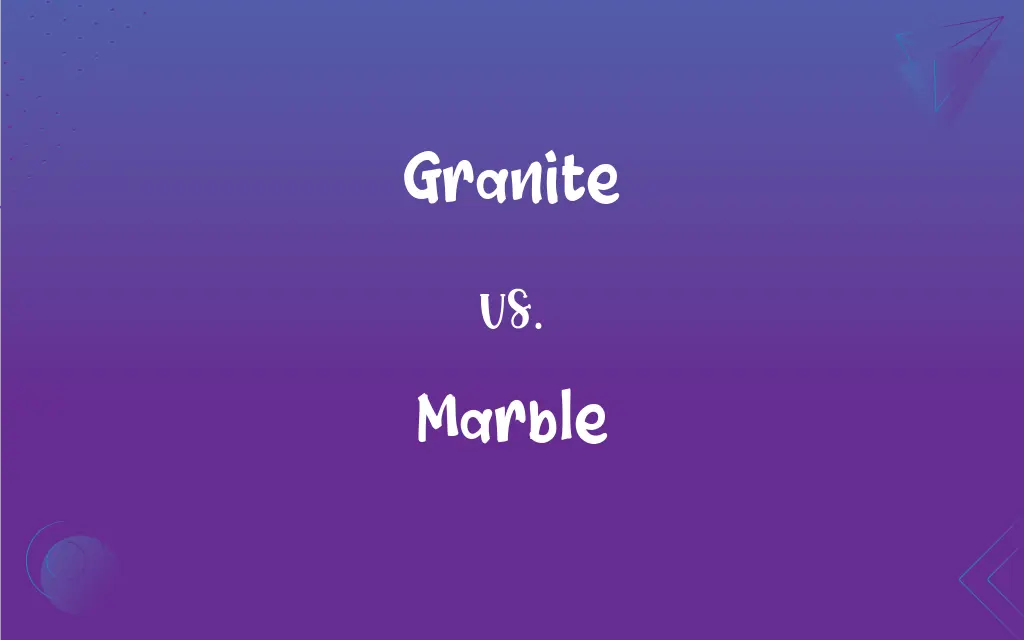Granite vs. Marble: What's the Difference?
Edited by Aimie Carlson || By Harlon Moss || Updated on October 24, 2023
Granite is a coarse-grained igneous rock, while marble is a metamorphic rock formed from limestone.

Key Differences
Granite and marble are both popular stones used in construction and design. Granite, known for its durability and strength, is an igneous rock formed from cooled magma. In contrast, marble, valued for its aesthetic appeal, is a metamorphic rock formed from limestone subjected to heat and pressure.
Granite and marble vary in terms of their appearance. Granite often displays a speckled or granular look with a mix of minerals, whereas marble has a smoother texture with characteristic veins running through it, often giving it a more luxurious appearance.
In terms of maintenance and durability, granite stands out. Granite is harder and less porous than marble, making it more resistant to stains and scratches. Marble, however, can be more susceptible to etching, especially from acidic substances, due to its calcium carbonate content.
While granite is commonly used for kitchen countertops because of its resilience, marble is frequently chosen for decorative pieces, sculptures, and certain types of flooring. Marble's softness allows it to be carved more easily than granite.
Cost-wise, both granite and marble can be on the pricier side when it comes to natural stones. However, marble often carries a higher price tag due to its luxurious reputation and the intricacies involved in its mining and processing.
ADVERTISEMENT
Comparison Chart
Formation
Igneous rock from cooled magma
Metamorphic rock from limestone
Appearance
Speckled or granular with mixed minerals
Smooth with characteristic veins
Durability & Maintenance
Harder, less porous, resistant to stains and scratches
Softer, prone to etching and stains
Common Uses
Kitchen countertops, outdoor installations
Decorative pieces, sculptures, certain floorings
Price
Generally more affordable
Often more expensive due to luxury reputation
ADVERTISEMENT
Granite and Marble Definitions
Granite
Granite is popularly used in construction due to its durability.
They chose granite for the outdoor patio because of its weather-resistant properties.
Marble
Marble is a metamorphic rock derived from limestone.
The statue was beautifully carved from a single block of marble.
Granite
Granite is a hard, coarse-grained igneous rock.
The kitchen featured countertops made of polished granite.
Marble
Marble is characterized by its veined patterns.
The green veins in the marble gave the table a unique touch.
Granite
Granite is formed from the solidification of magma.
The presence of granite indicates past volcanic activity in the region.
Marble
Marble is often used for sculptures due to its workability.
Artists prefer marble for sculpting because of its fine grain and softness.
Granite
Granite is frequently mined in quarries.
The local quarry extracts high-quality granite for export.
Marble
Marble can be polished to a high shine.
The marble floors in the lobby gleamed under the chandelier's light.
Granite
Granite consists of feldspar, quartz, and mica.
The vibrant colors in the granite come from the various minerals it contains.
Marble
Marble's primary component is calcium carbonate.
The marble reacted with the acid, indicating its calcium carbonate content.
Granite
A common, coarse-grained, light-colored, hard igneous rock consisting chiefly of quartz, orthoclase or microcline, and mica, used in monuments and for building.
Marble
A metamorphic rock formed by alteration of limestone or dolomite, often irregularly colored by impurities, and used especially in architecture and sculpture.
FAQs
Which stone is more expensive, granite or marble?
Typically, marble is more expensive due to its aesthetic appeal and luxury reputation.
Can both granite and marble be used outdoors?
Yes, but granite is generally more weather-resistant than marble.
Is marble suitable for kitchen countertops?
While marble can be used, it's more prone to staining and etching than granite.
What's the main difference between granite and marble?
Granite is a durable, coarse-grained igneous rock, while marble is a smooth, veined metamorphic rock derived from limestone.
Can granite be found in various colors?
Yes, granite comes in a variety of colors due to its mineral composition.
Are there different types of granite?
Yes, granite varieties differ based on mineral composition and location of extraction.
Is marble flooring slippery?
Polished marble can be slippery, especially when wet.
Which is harder, granite or marble?
Granite is harder than marble.
Is granite resistant to heat?
Yes, granite is heat-resistant, making it suitable for kitchen use.
How are granite and marble formed?
Granite forms from cooled magma, while marble forms from limestone subjected to heat and pressure.
Are granite countertops sealed?
Yes, granite countertops are often sealed to prevent stains and enhance durability.
Why does marble have veins?
Veins in marble result from impurities in the limestone during its metamorphic transformation.
Why is marble popular for sculptures?
Marble is soft and easy to carve, making it ideal for sculptures.
Does marble require regular maintenance?
Yes, marble is porous and can stain, so regular sealing and proper care are essential.
Which is more porous, granite or marble?
Marble is generally more porous than granite.
Which is heavier, granite or marble?
The weight can vary based on thickness and density, but generally, granite is slightly denser than marble.
Can I use acidic cleaners on marble?
No, acidic substances can etch marble due to its calcium carbonate content.
Can marble change color over time?
Yes, marble can develop a patina or change slightly in color with age and exposure.
How long do granite and marble surfaces last?
With proper care, both granite and marble surfaces can last for decades.
Is it easy to scratch granite?
Granite is resistant to scratches due to its hardness.
About Author
Written by
Harlon MossHarlon is a seasoned quality moderator and accomplished content writer for Difference Wiki. An alumnus of the prestigious University of California, he earned his degree in Computer Science. Leveraging his academic background, Harlon brings a meticulous and informed perspective to his work, ensuring content accuracy and excellence.
Edited by
Aimie CarlsonAimie Carlson, holding a master's degree in English literature, is a fervent English language enthusiast. She lends her writing talents to Difference Wiki, a prominent website that specializes in comparisons, offering readers insightful analyses that both captivate and inform.































































